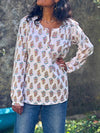
Khadi, this simple, raw, handwoven fabric, is a living symbol of the freedom, self-reliance, and resilience of the Indian people. Born in the fields and woven in homes, khadi carries within it the struggles, hopes, and indomitable spirit of those who sought to escape the yoke of colonization. Each khadi fiber tells a story of pride and resistance, a powerful bond between humankind, nature, and their land.
Khadi found its place in Indian history thanks to Mahatma Gandhi, who made it a symbol of the struggle for independence. At a time when India was flooded with British industrial textiles (while artisans were forbidden to work), Gandhi encouraged Indians to defy colonial prohibitions and return to their looms, spinning and weaving their own cloth, making khadi the emblem of swadeshi, or self-reliance. This simple fabric became an instrument of peaceful rebellion, a silent but powerful weapon against colonial oppression!
Wearing khadi at that time meant choosing to support the local economy, rejecting foreign domination, and returning to a simpler life, in harmony with nature and the work of one's hands. Khadi is therefore much more than a textile: it is a philosophy, a declaration of independence, an affirmation of human dignity.
Each piece of khadi is the result of meticulous handwork. The cotton, sometimes linen or wool, is spun by hand on traditional spinning wheels called charkhas, then woven on handlooms. This artisanal technique requires patience and expertise passed down through generations. No machine can replicate the texture, warmth, and unique imperfections of each piece of khadi.
The khadi-making process is a true homage to slowness and simplicity, in contrast to modern industrial speed. By wearing khadi, one connects with a more natural rhythm, with the raw power of human hands transforming a natural fiber into a fabric of life. It is an act of authenticity, a return to our roots, a profound respect for manual labor and artisanal traditions.
Khadi, with its slightly rough and irregular texture, is full of character. Its raw feel evokes the fabric's connection to the earth and the hand that shaped it. Unlike mass-produced textiles, khadi breathes, it lives, it adapts. It softens with each wash, becoming more comfortable over time while retaining its resilience.
The beauty of khadi lies in its simplicity, in its subtle imperfections that make it an authentic fabric. It is a reminder that perfection is not always smooth or uniform; it is often found in those small variations that tell the story of those who wove it, in the irregular beat of the loom, in the slightly thicker thread that resists.
But khadi isn't just an aesthetic choice; it's also an ethical commitment. Made from natural fibers, without the use of polluting industrial processes, it represents a sustainable alternative to textile overconsumption and fast fashion. Every meter of handwoven khadi reduces our ecological footprint, as it requires neither electricity nor machinery to produce. It's an eco-friendly fabric, respectful of the environment, in harmony with natural cycles.
Choosing khadi means supporting local artisans, encouraging a circular economy, and promoting a responsible lifestyle. In a world where everything moves too fast, khadi reminds us of the importance of slowing down, valuing quality craftsmanship, and caring for the planet. This fabric, born in the fields and transformed in Indian villages, is a model of sustainability at a time when the environmental emergency is more pressing than ever.




0 comments